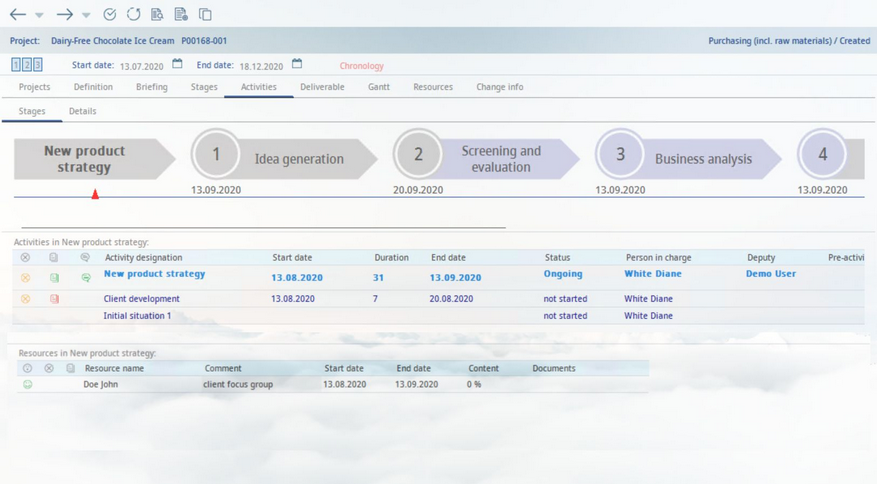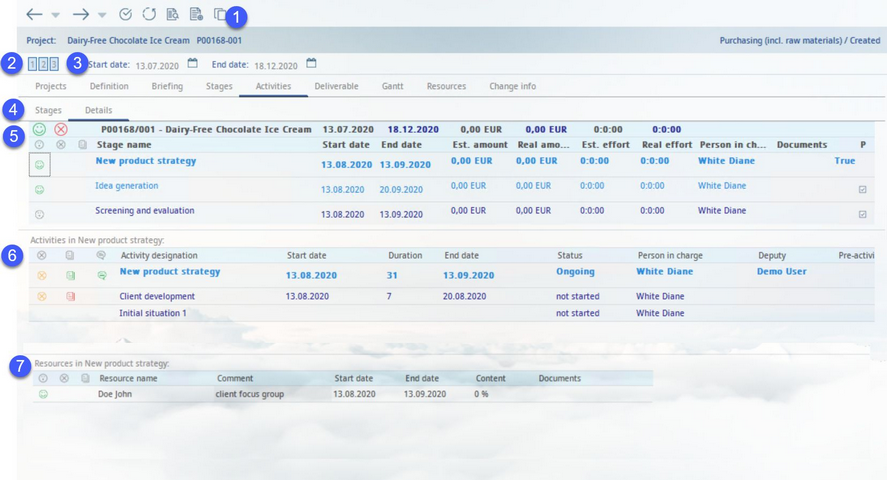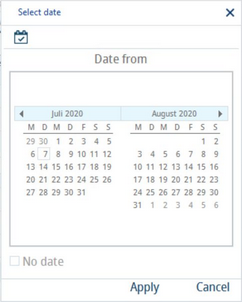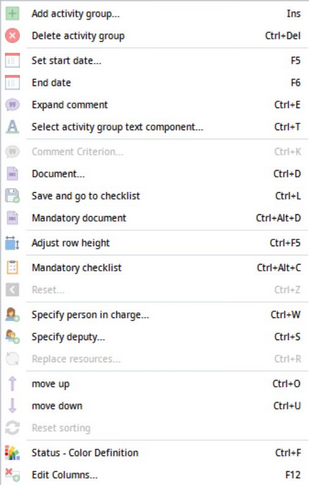In this tab, you can assign the three main types of project data:
•Stages (activity groups)
•Resources (people, equipment, machinery, etc.)
Calculation data, such as start date, end date, costs, etc. is calculated automatically from bottom to up (resources → activities → stages) and stored. This allows for detailed planning, as complex tasks can be divided into small simple steps, resources are used according to competence and capacity, project status monitored, and cost and time control improved.
The Activities tab can be viewed in two ways depending on the sub-tabs you are currently in; however, both tabs display all three types of project data. The first sub-tab called Stages, gives a quick overview of the project's stages via a diagram.
As it contains more information, this chapter will follow the second tab called Details.
1)Module Toolbar:
Aside from the usual taskbar buttons referred to to in Project → Functions & Processes → Basic Project Functions, the Activities taskbar has different functions as follows:

1. Load project stages/resources/activities from a template defined via Administration → General → Project → Project templates.
2)Make individual sections visible by using the buttons, as follows:
Button 1 opens/closes the Stages section.
Button 2 opens/closes the Activities section.
Button 3 opens/closes the Resources section.
3)Overview: As soon as you define the start data, end date, estimated effort/amount and real effort/amount, the information appears here with the amount and effort accumulated.
4)Switch between an overview and detailed view of the Stages section.
5)Stages section: Contains the following data:
![]()
![]() Status icon. Indicates the overall status of each stage. A green color indicates the stage advances according to the plan. A red icon indicates that the stage is overdue or the cost/effort has been exceeded.
Status icon. Indicates the overall status of each stage. A green color indicates the stage advances according to the plan. A red icon indicates that the stage is overdue or the cost/effort has been exceeded.
![]() Checklist icon. Indicates whether there is a checklist assigned to the stage. A yellow icon represents a checklist that is not done but not mandatory. A red color represents a checklist that is mandatory but not done. A green color indicates the checklist is done.
Checklist icon. Indicates whether there is a checklist assigned to the stage. A yellow icon represents a checklist that is not done but not mandatory. A red color represents a checklist that is mandatory but not done. A green color indicates the checklist is done.
![]() Document icon. Indicates that there is a document attached to the stage. If a document is mandatory for the selected field and it has not been uploaded yet, the icon is shown.
Document icon. Indicates that there is a document attached to the stage. If a document is mandatory for the selected field and it has not been uploaded yet, the icon is shown.
Project: This column has currently no function and can be disabled using right-click → Fade column in/out.
Stage name: The official name of the stage.
Comment: Comments can be entered using the right-click option Expand comment.
Start date: Can be selected from a calendar via right-click → Set start date. Changing the stage's start date will also affect the start date of its subordinate activities and resources.
End date: Can be selected from a calendar via right-click → End date. Changing the stage's end date will also affect the end date of its subordinate activities and resources.
Est. amount: The estimated costs. A sum of estimated costs of all activities belonging to the stage.
Real amount: The real costs. A sum of the real costs of all activities belonging to the stage.
Est. effort: The estimated activity duration. The total duration of the estimated effort required to complete all subordinate activities [days:hours:minutes].
Real effort: The real activity duration. The total duration of the real effort required to complete all subordinate activities [days:hours:minutes].
Executive: Can be assigned via right-click → Set owner person.
Representative: Can be assigned via right-click → Set representative.
Document: The attachment file name.
P: Select which stages should be included for reporting.
Right-clicking in this section brings up a context menu with the following options:
Add activity group: Insert another stage.
Delete activity group: Delete the selected stage.
Set start date: Select the start date from a calendar.
End date: Select the end date from a calendar.
Expand comment: Enter your comment in the Comment column.
Assign text components to activity groups: Insert a text component in the Comment column. To delete the text component, use the Expand comment option and delete the content of the Comment column. See General Information → Using Text Components for more information.
Comment criterion: A different color used for the stage name means that a criteria comment is present in the criteria structure → field Comment and can be viewed using this option.
Document: Attach a file.
Save and go to checklist: Save the changes and go to the Deliverable tab with the current stage preselected.
Mandatory document: Make attachment mandatory for the selected stage.
Adjust row height: If selected the row height will adjust according to the volume of the text in the Comment field.
Mandatory checklist: Make checklist mandatory for the selected stage.
Rollback: Reset a completed stage to active status by creating a new release.
Set owner person: Select the responsible person or group from the list of users (created via Administration → General → User Settings → User).
Set representative: Select a person or group from the list of users as the stage deputy (created via Administration → General → User Settings → User).
Replace resources: To share responsibility, representatives and resources.
Move up/down: Move stage one place up/down.
Reset sorting: Stages can be sorted by name, effort, etc. by clicking on the respective column header. This function resets sorting to the original sorting of the project.
Status color definition: Define status colors used for highlighting.
Edit columns: Show or hide columns. It is also possible to rename columns by double-clicking on their name.
6)Please refer to Activities for more information.
7)Please refer to Resources for more information.



